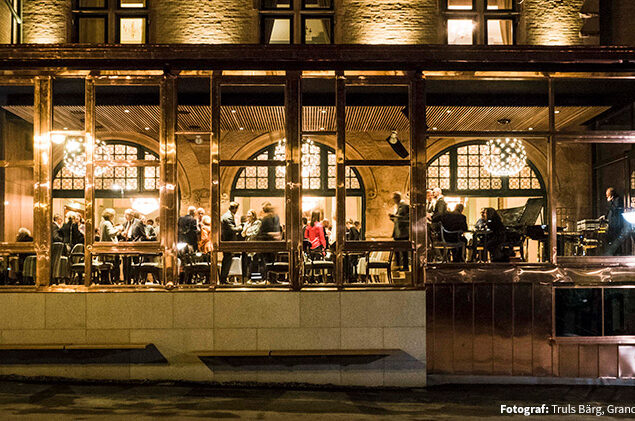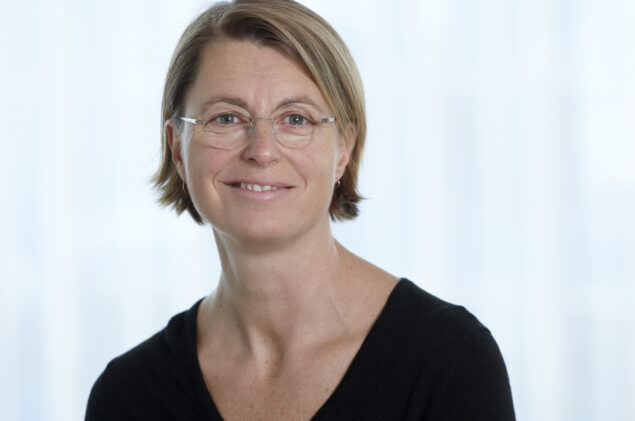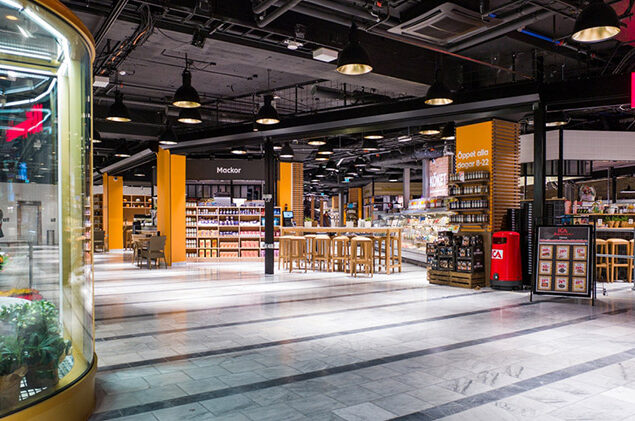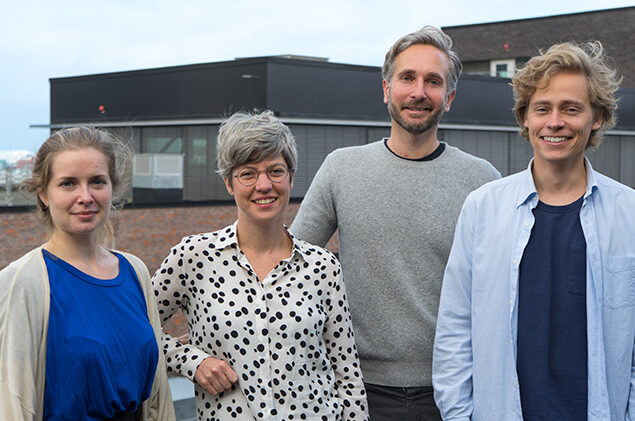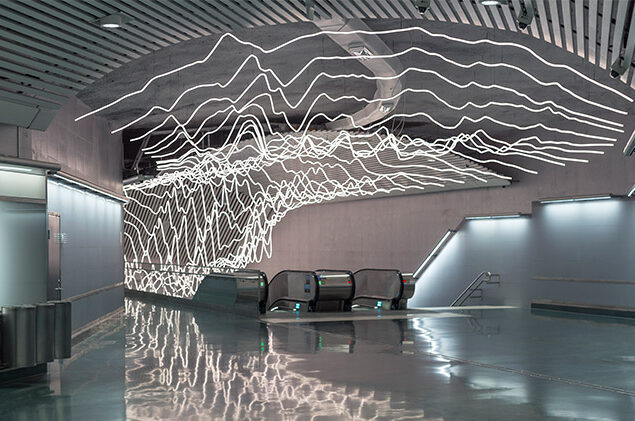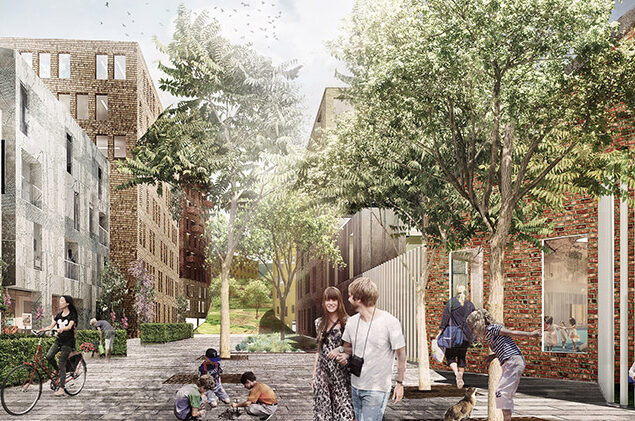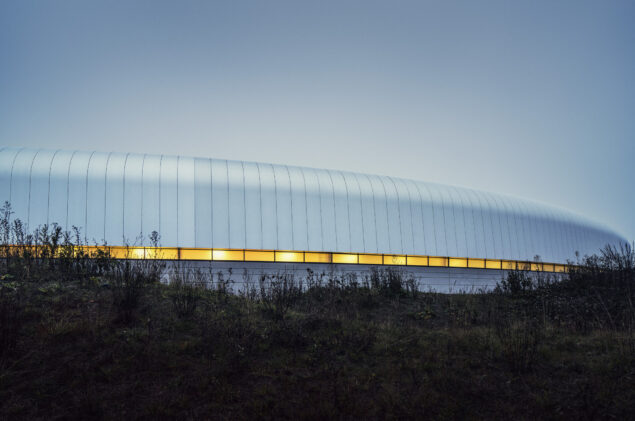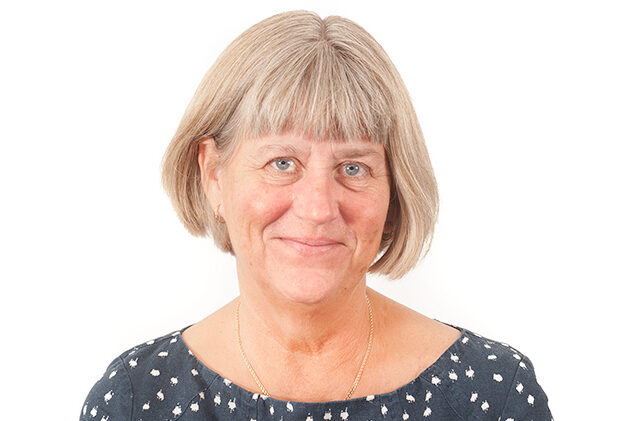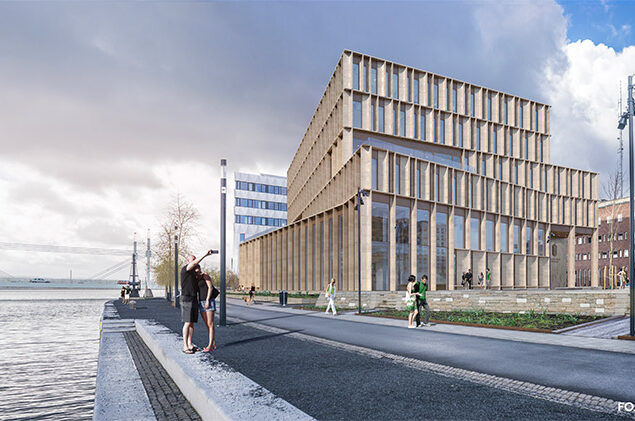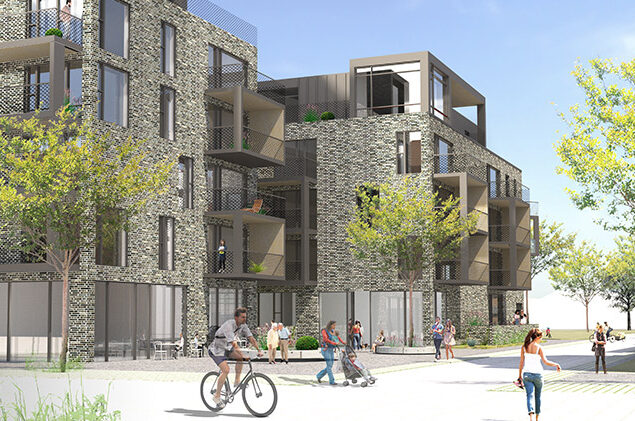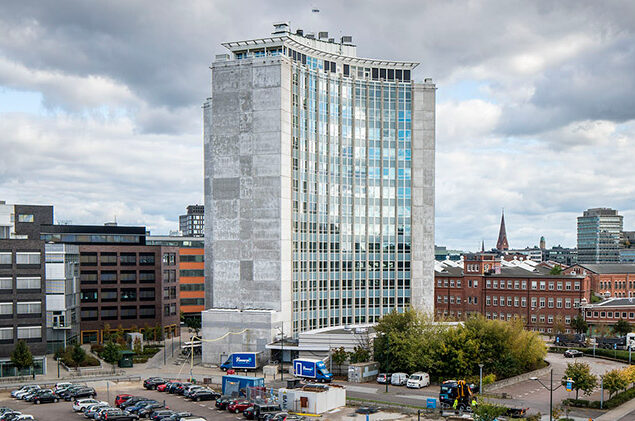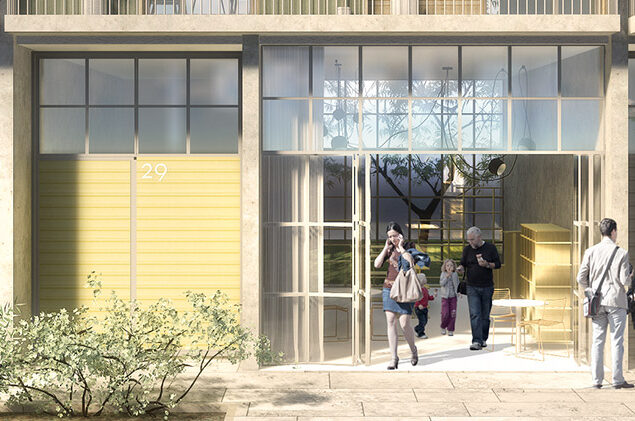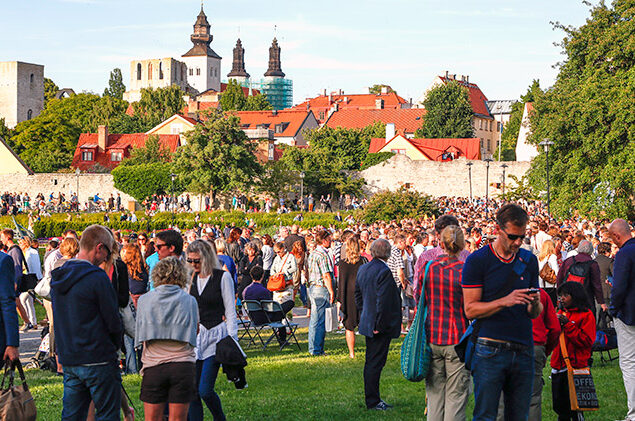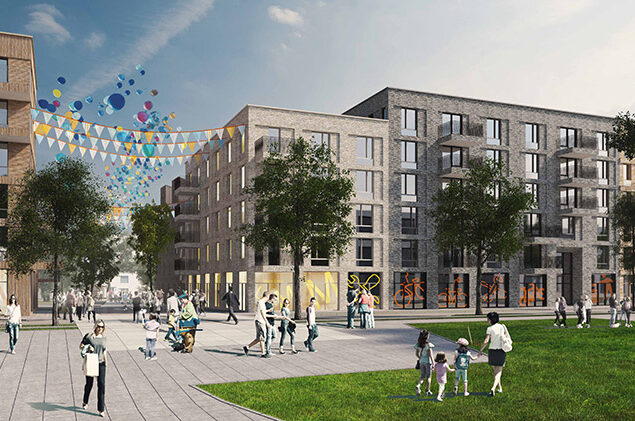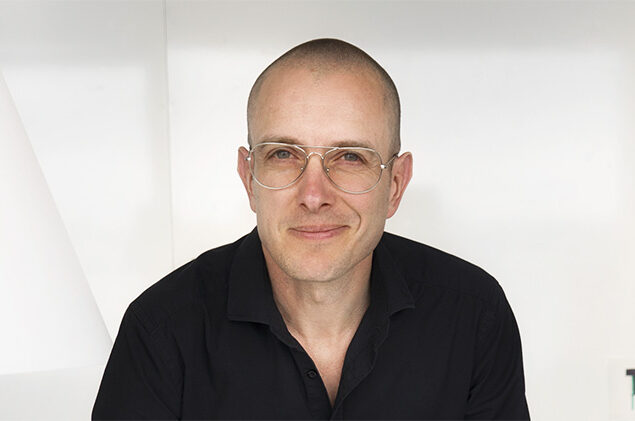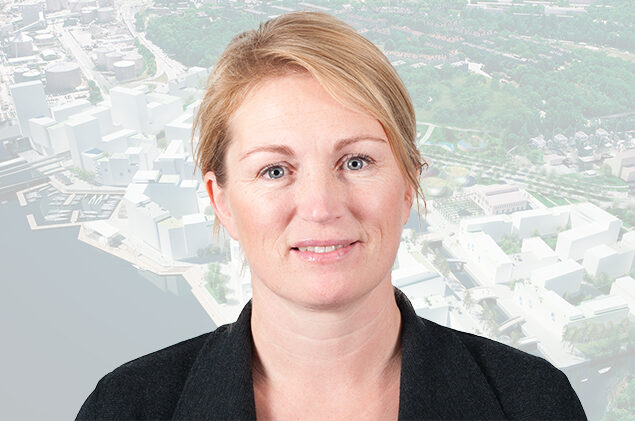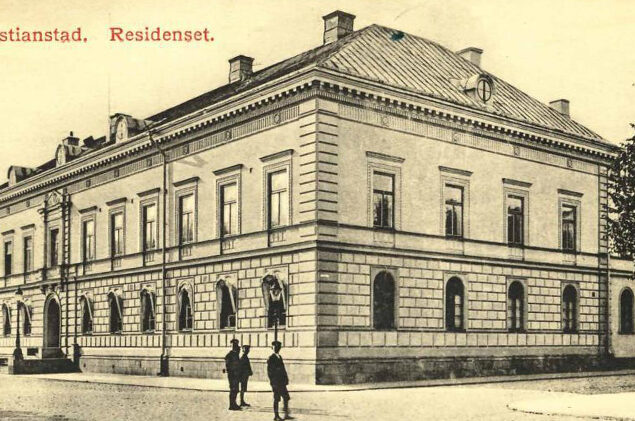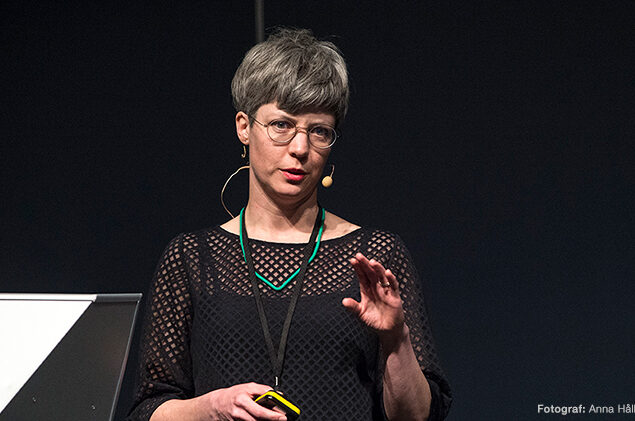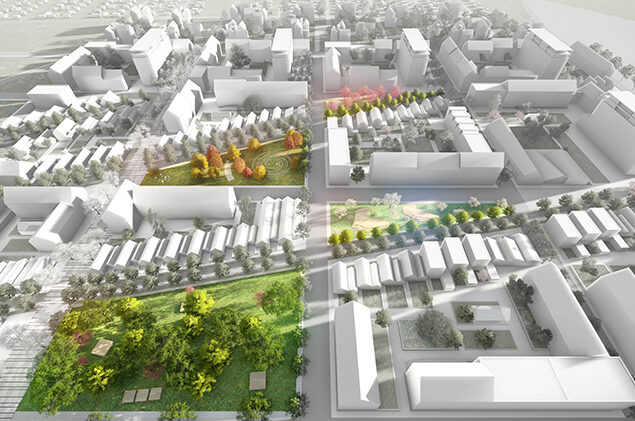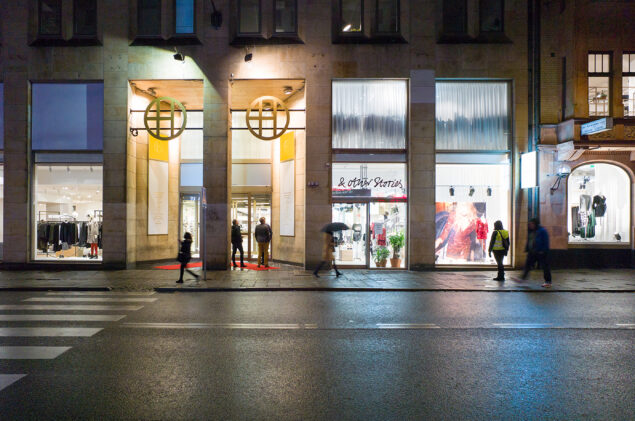2017-11-15
Eye clinic first to move into Helsingborg Hospital's eastern wing
FOJAB arkitekter and BSK Arkitekter are jointly responsible for the major transformation of Helsingborg Hospital's main building. The first phase is now complete and the eastern wing is getting ready for occupancy. The first to move into the new premises is the eye clinic.
Helsingborg Hospital is being rebuilt to meet future requirements for modern care units and treatment methods. The aim is to create a general and flexible structure that will be able to function for different types of activities in the future.
The first phase has included program, system and construction documentation for the 12,000 m² East Wing of the hospital's characteristic cruciform building. The wing has been completely renovated both internally and externally, all technical systems have been replaced and the facade is new. The Eye Clinic/Operation on the 15th floor is the first to move into the new premises, followed by a phased move of wards.
An important starting point in the project has been the orientation and light in the premises. The eye clinic has a simple and clear floor plan with large glass sections that let in daylight from all directions. Colors and material choices are consistently light with wood elements, and permeate the entire wing. More and better spaces have been created for both staff and patients.
- As architects, we can make a big difference for patients and staff. The soft values are very important. I am thinking of views, daylight, beautiful colors and good materials. The physical environment should be both beautiful and functional," says Anna Hjort, commissioned architect at FOJAB arkitekter.
Work will now begin on emptying the North Wing, which will undergo an equally extensive renovation and is expected to be completed in 2019. Similar work is planned for the South and West wings in 2019-2023.
2017-10-26
Grand Hotel in Lund's new verandas have been inaugurated
FOJAB arkitekter was commissioned to design the new verandas of the Grand Hotel in Lund. In close cooperation with Grand's owners, two new glass verandas, an outdoor terrace and a back pocket have now been built adjacent to Bantorget. The new verandas have been given their own character from the building and become a natural part of the adjacent square.
Grand Hotel is one of Lund's oldest and most classic hotels and also has a restaurant. The hotel was designed by the city architect in Helsingborg Alfred Hellerström and was built in 1896-98. The building and verandas have undergone several renovations over the years.
The assignment involved the addition of glass verandas, a back pocket and an outdoor dining area adjacent to Bantorget. The ambition has been to give the verandas a modern expression and functionality, while at the same time linking to the hotel's history and meeting the high requirements for antiquarian preservation. To support the careful handling of the building, FOJAB has collaborated with an antiquarian expert.
- An honorable and extremely interesting assignment. It is about preserving and modernizing, without destroying the historical values," says Mats Molén, the architect in charge of the project.
The verandas have high opening glass sections that create good contact with the patio and the square. In the western veranda, outside the Piraten foyer, there is space for a small stage. Large level differences in the ground gave us the opportunity to utilize the area and create a back pocket under the western porch. The back pocket will serve drinks to the outdoor terrace. Guests will be able to sit on wall-mounted benches with tables below the two verandas, as well as on an outdoor seating area facing Lilla Fiskaregatan.
The verandas are built with sustainable and character-building materials that age beautifully. The granite base interacts with the copper plate of the windows and the sandstone facade of the building. The verandas have their own character from the building and become a natural part of the square, creating movement in the surrounding urban spaces. At the same time, Bantorget is being rebuilt to be an inviting entrance to the city and contribute to a vibrant city center.
The working group at FOJAB consists of Mats Molén, Mikael Pettersson, Christina Sammer and Matilda Emgård.
2017-10-13
Charlotte Kristensson speaker at the conference "School and preschool environments of the future 2017"
Charlotte Kristensson is an architect responsible for knowledge environments at FOJAB arkitekter. On October 18-19, she will speak at the conference "School and preschool environments of the future 2017". The theme is strategic planning of sustainable school and preschool environments adapted to modern ways of working in schools.
The municipality of Lund has developed a new standard and program that will apply to all new primary schools in the municipality. Charlotte talks about a solid work with functional programs where, among other things, new calculation models based on the curriculum have been developed. She also talks about how they have worked with participatory processes to create influence and participation in the design of the municipality's new primary schools.
2017-10-01
Hofs Park - Future housing for the elderly in Växjö
Last autumn, Växjöbostäder AB arranged an idea competition regarding a concept for how the future housing for the elderly in Växjö should be designed. FOJAB, together with the real estate company APP Properties, has developed a unique neighborhood for the target group 55+.
The design is based on the basic idea of letting the park and the green environment characterize living in Hofs Park. The park creates community for the residents and promotes a social and active life in the neighborhood. Green paths, walkways and outdoor environments interact well with the sculpted buildings and the surroundings. Adjacent to the park and square are the neighborhood's common facilities, such as a restaurant and café, gym, indoor and outdoor pool. Together with the boule and tennis courts, the pensioners' house, medical center and shops form a whole. The block will also include a preschool, which contributes to a vibrant neighborhood.
Hofs Park has high environmental and sustainability standards from a social, ecological and economic perspective. The idea is to install solar cells and meters for electricity, hot and cold water where residents can compare their consumption with an average for the area. This will further enhance the attractiveness of the neighborhood and contribute to Europe's greenest city. Construction of Hofs Park is planned to start in the fall of 2018.
2017-09-30
FOJAB nominated as best consultant in NCSC Sweden Awards
We are nominated in the category Consultant of the Year 2017 for our work on the design and planning of the central shopping area Hansa in Malmö.
The nomination reads:
"In a tough retail market and with a history in good old commercial areas in Malmö, they have managed to lift a department store to new modern levels.
Good retail space planning and appropriate design allows both new and old concepts to succeed in limited spaces and premises.
Hansa in Malmö has been given a dignified new life thanks to the careful architectural work of Fojab."
In close cooperation with the client AREIM and HEA Property Partner, we have worked to refine both of Hansa's blocks into a modern and attractive commercial area in the center of Malmö. The neighborhood has a mixed-use character where shopping, restaurants and cafes are mixed with offices, schools, medical centers and housing.
- "Let's gild Hansa" was the basis of the design idea - gilding has indeed permeated the entire project. From the facades, which are almost finished, to the gold-colored construction helmets at the workplace. "Thanks to good cooperation and clear goals, we have succeeded very well with the project together with the client," says Per-Aage Nilsson, commissioned architect.
2017-09-28
Interview with Lars Nilsson, "bicycle architect" at FOJAB
The bicycle is a convenient way to get around. But it is more than that. For many, cycling is as much about design and aesthetics as functionality. For many, it is a lifestyle. The benefits of cycling are also many - less congestion, better environment, better public health and attractive urban environments. Architect and cycling enthusiast Lars Nilsson became interested in bicycles when he bought his first bike at the age of 16 for SEK 535.
Lars Nilsson speaks at a fast pace, you can tell he is enthusiastic. We took the opportunity to ask him some questions.
How did you become interested in this?
- One early summer day about 15 years ago, I got the idea to start cycling to work. I took over an old bike from a colleague. Then I got two more and thought I wanted to do something with them. I wanted to add a personal touch. That's when I started buying parts and accessories on eBay - and that's where my interest in bike design was born.
You have built around 20 bikes over the years, almost exclusively for colleagues and friends. Where do you find inspiration?
- Sometimes I am given a free hand, but mostly I build the bikes according to the customers' wishes and requirements. I am very much inspired by old models and today you can find lots of inspiration on the Internet. It usually starts with me running into a nice part - a nice saddle or handlebar stem. Then I start from there and come up with an idea. At home I have a large stock of parts.
Do you benefit from your professional role as an architect?
- The creative side and the desire to create is something I have with me. Assembling a bike is a fairly large project. You can compare it to a construction process where you "assemble a house" but on a much smaller scale.
Lars advocates the environmental and urban aspects of cycling, among other things. How can we get more people to cycle?
- We need to plan the city for increased cycling. Cities like Copenhagen and Malmö are leading the way. Copenhagen tops the list of the world's best cycling cities. Sixty percent of people there cycle to work, while only fourteen percent take the car. "By expanding cycle paths, making sure that pedestrians know where to go and creating more cycle parking, we can increase cycling in cities. And I believe that rental bikes are the future - Malmö is doing a great job.
How many bikes do you own?
- I have eight bikes of my own! But I'm close to work so I prefer to walk. But there was a time when I cycled between the office in Malmö and my home in Lund.
2017-09-27
The FOJABcode team is in place!
FOJABcode is our computational design initiative to develop digital design processes. A strong team is now in place to explore how digital developments are changing our role as architects, the built environment and the construction process. This means that we can analyze and drive the design from several parameters that are crucial for our clients' projects.
Hello Petra Jenning, Jens Jacob Jul, Henrik Malm and Elin Daun from FOJABcode!
What are you working on?
- We work with design research and method development in the field of computational design. This means that we look broadly at the design process to explore new possibilities that open up with a digital approach to architecture, from the first sketch to manufacturing. We work on projects at different scales to find solutions to everything from specific problems to advanced design. It can be about how people move, solar radiation and energy but also materiality and spatiality. We model behaviors and processes and identify data that can drive a digital design process.
What are the benefits of computational design in architecture?
- Computational design allows us to handle more facts in the design process than before. This creates opportunities to find new solutions that better meet the needs and functions required. We can allow the computer to generate solutions where interaction and feedback between different functions and systems are baked into the design process. We usually say that the computer can give us more senses - we can understand more of what we do and create. When we link this to a digital manufacturing logic, it opens up new possibilities for the built environment.
What is the objective of the initiative?
- We want to take a holistic approach to what digitalization means for the entire chain of the construction process - from design to production to finished house - and beyond. We work to develop methods where digital thinking supports innovation. Architecture tends to become increasingly general - by using new digital tools and data collection, we can resource-efficiently create architecture that is more unique and meets the specific situation of each building.
2017-09-18
A successful collaboration between art and architecture
Edvin Bylander is an architect at FOJAB arkitekter and has collaborated with artist David Svensson since 2012. Together they have worked on artworks for the Citybanan in Stockholm, the New Karolinska Hospital in Solna and the hospital in Angered. Their first project is Citybanan's Odenplan station, which opened in July.
Edvin and David's collaboration is based on a shared understanding of the relationship between art and architectural expression. Many of David's artworks are in the public space and he identified early on a need to find an architect who could help with drawings and visualizations.
- 'We work very well together and have found a working process that works. Edvin helps to provide an understanding of spatiality and scale," says David Svensson.
The artwork 'Life Line', which adorns the escalator room at Odenplan station in Stockholm, is a 350 square meter light piece inspired by the heartbeat of David's son Isaac.
- For the Citybanan station at Odenplan, I have endeavored to develop an artwork with a clear identity and a tangible presence, in harmony with the station's architectural spatiality and function. The work is based on the pulse of my son Isaac before his birth in the summer of 2012. The luminous lines showing the baby's pulse become a metaphor for life. I see a train station as the pulse of a city and its life, so it also becomes a nice metaphor," David continues.
- It is a unique piece of art and an incredibly exciting project. David had a clear idea of how he wanted to design the artwork. I have then worked on modifying the art in a spatial context, in this case a 400 square meter rock room, says Edvin Bylander.
A challenge with the artwork has been to manage the complexity and make it buildable. Edvin has coordinated with the architect of the city railway, who among other things provided a 3D scan of the entire cavern.
- At FOJAB we have a special competence to deal with this kind of complexity. We work with digital design and based on a 3D model of the room, we do it on a spatial scale. We focus on how it will be realized and relate to the surrounding architecture," says Edvin.
David and Edvin advocate the importance of integrating art and creating a holistic approach to design. They want to work on larger projects together, where art and architecture can be integrated at an early stage. David also emphasizes that art must enter the building process and work as early as possible. Too often the artist only comes into the picture once the building is completed. They both agree on the important role of art in the design of public spaces today.
- We will only see more art integrated with architecture. Public art can help create new and exciting architecture and places you want to stay. The place is given an identity with content and meaning," concludes David.
2017-09-14
Kolkajen nominated for the Swedish Architects' Plan Prize 2017
Architects Sweden has nominated the City of Stockholm's planning work with Kolkajen for this year's planning award. We are very happy and proud that FOJAB arkitekter is involved in the project.
Kolkajen is part of Stockholm's major investment in the development of Stockholm Royal Seaport and one of Sweden's largest development areas. Stockholm wants to create good conditions for cyclists and pedestrians, and the ambition is to create a neighborhood that is as car-free as possible. The number of parking spaces per apartment is low. The most sustainable and climate-smart district in Sweden will be built.
The nomination in Kolkajen concerns, among other things, the work on the detailed plan and design program. FOJAB arkitekter is currently working on developing all detailed plans, design programs and programs and system documentation for street and play environments in the area. Through a previous prequalification and parallel assignment, FOJAB has entered into a framework agreement with the City of Stockholm for the continued work. Karin Fagerberg is a planning consultant on behalf of FOJAB in the Kolkajen N Djurgårdsstaden project.
The Plan Prize is awarded to stimulate and disseminate good examples of good Swedish urban planning or urban design. It was established in 1992 by the former SAR, the Swedish Architects' Association, and has been awarded by the Swedish Architects since 2002.
The winner of the Plan Prize will be presented at the Architecture Gala on November 28 at Cirkus in Stockholm.
2017-09-07
MAX IV is nominated for the Steel Building Award 2017
The MAX IV laboratory in Lund is one of five nominees for the Steel Building Award 2017. The Steel Building Prize is awarded every two years to a building that uses steel in the load-bearing structure in an innovative, environmentally sustainable and architecturally appealing way.
In 2010, FOJAB arkitekter was chosen to design and plan MAX IV for Lund University with Fastighets AB ML4 as the developer. Snøhetta arkitekter was chosen as landscape architect. The project strives for a symbiotic relationship between landscape, external building form and internal form. The large experimental hall's roof lantern with its brushed aluminum surface, the office building's white sheet metal cassettes and horizontal sun protection for windows, the other buildings' white concrete facades together with the undulating landscape have made the MAX IV laboratory a distinctive landmark at Lund's northern entrance.
The Steel Building Prize will be awarded during the Steel Building Day, Thursday, October 26, at Stockholmsmässan in Stockholm. The aim of the award is to encourage the efficient use of steel in construction and to generate new ideas and inspiring solutions.
2017-08-30
Cecilia Pering is the new chair of Sustainable Business Hub AB.
Cecilia Pering has been the new chair of Sustainable Business Hub AB for a few months now. The network works to strengthen the competitiveness of Swedish environmental technology and stimulate the development of sustainable societies.
The network brings together over 100 members from business, public sector and academia with technological solutions as well as ambitions for a more sustainable society. The Sustainable Business Hub provides members with a platform for innovation, development and business for sustainable solutions. By connecting urban challenges with academic and business solutions, the network helps to drive the development of sustainable societies forward.
Cecilia is an architect at FOJAB arkitekter with extensive experience as a project manager for large architectural assignments. She was previously CEO of FOJAB and is now active as a Senior Partner with a focus on strategic management issues.
- "I am delighted to be entrusted with this position and look forward to taking part in the innovation work going on in the region. I hope to contribute with my experience and support interesting projects in sustainable development," says Cecilia Pering.
2017-08-24
Profit in parallel assignment - FOJAB designs new building for Göta Hovrätt and Kammarrätten in Jönköping.
After a parallel design assignment, Castellum, in collaboration with the Swedish National Courts Administration, has now chosen to proceed with FOJAB's proposal for a new court building in Jönköping.
A unanimous jury selected FOJAB's proposal as the winner, highlighting its strong architectural design and qualities in the urban space.
From the jury's statement: "FOJAB presents a consistent facade design with vertical elements that nicely holds the different facade lives - the different volumes - together as a whole. The building is slightly set back from the property line, which is used for public spaces. They are located towards the park and Lake Munksjön and are considered to be a positive addition to city life....Fojab's proposal is considered to best meet the expectations we have of a court building".
- "We are extremely proud and happy about this prestigious assignment. At FOJAB, we have extensive experience of working with court buildings and the special functional requirements associated with this type of project. This, in combination with a strong idea, has paved the way for a high quality proposal," says Kjell Adamsson, responsible architect at FOJAB.
The new Court of Appeal building fits into the existing structure and connects the buildings along the western shore of Lake Munksjön. The building volume is built up with different scales in relation to its context and the surrounding urban environment. The building is pulled back from the plot boundary, which creates areas for the public to stay and move around the new court of appeal. The urban spaces are also activated by distributing several different entrances around the building, which creates life and movement.
The façade is designed with light sand-colored vertical and horizontal elements. The vertical elements limit the direct solar radiation and enhance the design of the building. The building has been specifically designed with the availability of daylight and the high environmental ambitions in mind. The building is designed to meet the requirements of the Miljöbyggnad level GOLD certification system.
- Based on a strong idea, we have developed a project of high architectural quality. The new court building has a strong character and dignity that takes advantage of the unique location and urban space at Munksjön," says Stefan Johansson, architect and creative director at FOJAB.
The competition team consisted of Stefan Johansson, Mikael Pettersson, Catarina Boström, Natalie Adelhoefer, Jonas Ruthblad and Kjell Adamsson.
2017-08-21
FOJAB arkitekter wins competition for new housing in Ängelholm, Sweden
After an architectural competition, FOJAB has been commissioned by Melin Förvaltning to design a completely new neighborhood on the old sugar mill site in Ängelholm. The block includes about 110 apartments close to the station, the sea and the city. Construction of the new residential buildings is planned to start in 2019.
The proposal meets the vision for the Ängelholm station area of an attractive residential area with improved connections between the city and the sea. The block's clear target points are the station, the sea and the city, and the block structure opens up towards these. Small scale and the advantages of small town life are clearly reflected in the proposal.
- Our 'Quartet' proposal draws on the best of the traditional block structure and the point house. The result was a hybrid - two different house types with a triangular plan shape surrounded by greenery and built around a common courtyard. "We wanted to create a vibrant neighborhood with courtyards and spaces for social life," says Ulrika Sellin, architect at FOJAB.
- "FOJAB has produced an attractive and innovative proposal on how to make the best use of valuable land area," says Håkan Svensson, CEO of Melin Förvaltning.
The building volumes vary between five and eight storeys and are built around a raised communal courtyard, which offers spaces for cultivation, greenhouses and play. The brick buildings are architecturally linked to the older buildings in the sugar mill area and contribute to the dignity and durability of the buildings. The apartments are open plan and most have a balcony or terrace. The large buildings have generous "balcony rooms" facing south and west.
The architecture is characterized by simplicity and clarity with a natural variation, as the buildings are perceived in completely different ways depending on the direction from which they are viewed. Despite the open block shape, there is a clear structure with private and public spaces.
FOJAB's architectural team consisted of Ulrika Sellin, project manager, Nina Torstensson, design manager and Catharina Hansson, contributor.
2017-08-21
Gängtappen is one of the finalists in the Green Lance 2017 competition.
Gängtappen has been named a finalist by the City of Malmö in the Green Lance 2017, the city's award for environmentally sustainable and climate-smart construction.
FOJAB was commissioned by Wihlborgs Fastigheter to be responsible for the renovation of the characterful office building. The project involved a complete renovation to create modern and flexible office space. The focus was on retaining and preserving the original qualities.
Motivation of the jury: "After a thorough clean-up and careful renovation, a piece of Malmö history is stepping into the future. A new climate shell and smart energy systems, together with sound material choices and flexible workplaces, have resulted in an impressive improvement in the building's energy performance and sustainability. Through the architectural and environmental improvements, Gängtappen is an important model for the necessary environmental adaptation of the existing city."
This year, the committee has chosen to nominate three finalists, with one of the projects taking home the Green Lance, which will be awarded during the Urban Development Day on September 1 at Malmö Börshus.
2017-07-03
FOJAB arkitekter and Fler Bostäder are building two blocks in Sigtuna stadsängar.
FOJAB arkitekter and Fler Bostäder AB have signed an agreement with Sigtuna stadsängars exploaterings AB and will build two blocks in the new district. The blocks are characterized by high sustainability goals and innovative architecture.
Sigtuna stadsängar is a completely new district located just north of the old town center in Sigtuna with the goal of being Sweden's most sustainable district. FOJAB and Fler Bostäder will develop and build two blocks of approximately 60 tenant-owned apartments in blocks 17 and 18.
High sustainability goals have set the tone for the project idea, which fits well with Sigtuna stadsängar's ambitions. FOJAB and Fler bostäder will focus in particular on social sustainability.
- We are pleased to be entrusted with the development of Sigtuna Stadsängar together with Fler Bostäder. Based on a strong idea, we are developing a unique project with high architectural quality. By taking greater responsibility for the whole, we are deepening our expertise," says Kjell Adamsson, architect and business development manager at FOJAB.
- We look forward to being involved in developing a new exciting neighborhood. Fler Bostäder has the ambition to create long-term sustainable housing environments for more people from a social, ecological and economic perspective, says Magnus Knutsson, CEO of Fler Bostäder.
The project idea is based on the idyllic city center of Sigtuna with its qualities in terms of neighborhood structure, materiality and scale. The mix within the neighborhood is shaped by different typologies; the townhouse, the apartment building and the villa, stacked on top of each other. Ground floor dwellings open up to the street with multifunctional spaces. Greenery grows on the facades facing the courtyard. The block has direct contact with the city and common spaces for socializing, linked to nature and lush courtyards.
- FOJAB and Fler Bostäder have well met the expectations of a sustainable, innovative and exciting project in line with our development strategy and sustainability levels, says Kim Hultén, operations manager for Sigtuna stadsängar Exploaterings AB.
FOJAB and Fler Bostäder are forming a joint project company for the development of the blocks in Sigtuna stadsängar. The cooperation is strategic and long-term and the ambition is to have more projects in Sigtuna and other nearby locations.
Work is now beginning on the design of the properties. Sales are expected to start in January 2018 and construction will begin in spring 2018.
2017-06-29
FOJAB arkitekter focuses on project development
FOJAB arkitekter has made a strategic decision to expand its business and is now focusing on project development under the name FOJAB development. This is a platform for entering into partnerships and developing projects in-house. Initially, a collaboration is entered into with Fler Bostäder AB.
With the desire to take greater responsibility and develop its own projects, FOJAB is broadening its activities. The aim is to further sharpen our architecture and gain greater experience and knowledge of project economics, feasibility and the construction process. Through an increased understanding, FOJAB will create added value for customers and clients in all its projects.
Kjell Adamsson, architect and business development manager, will be responsible for the development of the new business.
- FOJAB development is a natural step in our business. By developing projects in collaboration with different actors, we can take greater responsibility for the whole and influence all parts from finance to design. This will make us a better partner for all our clients," says Kjell Adamsson.
Initially, a partnership is being established with Fler Bostäder, a relatively young company with a lot of experience and commitment to housing development.
- We are very pleased to be working with FOJAB arkitekter. They have an extremely broad knowledge in the various areas of architecture combined with an understanding of the conditions of the projects. Through the collaboration, we benefit from our shared commitment and create new interesting business opportunities, says Magnus Knutsson at Fler Bostäder.
FOJAB's focus on project development also creates the conditions for architecture to take on a greater role. Joachim Lundquist, Head of Architecture at FOJAB, comments:
- High-quality, idea-based architecture creates long-term value and sustainability. We bring this driving force into all our projects. Now that we can influence processes and decisions to a greater extent, we are more likely to create strong ideas and concepts that last all the way to execution.
2017-06-26
FOJAB architects in Almedalen!
Almedalen Week is fast approaching. We will be on site and are happy to talk about architecture, urbanization, challenges in the dense city, future housing and digitization. We are looking to the future, sharing experiences and providing insights.
We will be there from 3 to 7 July and participate in 5 events:
MONDAY 3/7 - SWEDEN'S MOST SUSTAINABLE DISTRICT GIVES LAND DISCOUNT FOR INNOVATION POWER
Participants from FOJAB arkitekter are Kjell Adamsson.
TUESDAY 4/7 - CITIES AND URBAN LIFE OF THE FUTURE
Participants from FOJAB arkitekter are Edvin Bylander.
TUESDAY 4/7 - CONSTRUCTION AND DIGITALIZATION
Participants from FOJAB arkitekter are Petra Jenning.
WEDNESDAY 5/7: ALMEDELA - HOW DO WE WANT TO LIVE IN 2030?
Participants from FOJAB arkitekter are Ida Stavenow.
FRIDAY 7/7: HOW DO ARCHITECTS SOLVE THE HOUSING CRISIS?
Participants from FOJAB arkitekter are Edvin Bylander.
On site from FOJAB are Anders Eriksson, Cecilia Pering, Daniel Nord, Edvin Bylander, Emma Schöön, Ida Stavenow, Jens Larsson, Joachim Lundquist, Karin Fagerberg, Kjell Adamsson, Magdalena Hedman, Magnus Lundström, Petra Jenning.
2017-06-14
FOJAB wins land allocation competition together with Bonava in Rosendal, Uppsala.
Together with Bonava, FOJAB is the winner of the land allocation competition for Rosendal phase 3 in Uppsala. The proposal is based on the municipality's vision for the area: In Rosendal everything is close, Everyone is welcome, A smarter district.
Rosendal is a completely new and rapidly growing district close to the center of Uppsala. The district will be an area with a mix of housing, commerce, services and proximity to green parks and nature areas. The assignment was to create a vibrant residential district with a focus on sustainability.
- "Uppsala Municipality has a high level of ambition for the area and it is gratifying to participate in this major initiative in Rosendal together with Bonava. We have presented a strong proposal with clear urban qualities where the green surroundings are really woven into the block," says Jens Larsson, office manager and architect responsible for the project at FOJAB in Stockholm.
The winning proposal, "Kvarterskalaset", is based on a vibrant ground floor with courtyards and paths that encourage a social, sustainable and active lifestyle. Common functions are gathered around a central lobby that serves a variety of purposes. The courtyard opens up to the park in the east and the parkway in the north. The block is given a strong design with facades of brick and wood that contribute to creating character in Rosendal.
- We wanted to create a neighborhood full of life and movement. It creates opportunities for people of different ages to meet, socialize and interact. For us, form is always central, so we have created a long-term sustainable architecture - a design that stands the test of time," says Jens Larsson.
FOJAB has also proposed a sustainability concept focusing on mobility services, smart technical solutions and green building. Through a technical platform, residents can meet their neighbors, share resources and keep track of their homes via phone or computer. Functions that contribute to community and inspire a social and environmentally conscious lifestyle.
The competition proposal will now form the basis for further work on the program and building permit documents. If the work goes as planned, construction of the block will begin in 2019.
2017-05-18
Well-attended architecture salons in both Malmö and Stockholm
During the spring, we organized two well-attended architecture salons in Malmö and Stockholm. In Malmö, there were interesting discussions about Virtual Reality where visitors took the opportunity to look into the future and deepen their knowledge. At the Stockholm office's seventh architecture salon, 'The beauty of the city' was debated. This is an urgent issue in a time of intensive construction and many large-scale projects.
FOJAB arkitekter's Malmö office organized architecture salon #2. on the theme Virtual Reality - experiences and visions. Some fifty visitors took the opportunity to explore the future and deepen their knowledge of VR. There was mingling and food followed by an illuminating and interesting panel debate. There were also test stations where visitors could visually step in and experience ongoing projects.
Petra Jenning, architect and responsible for FOJABcode moderated between exciting contributions from Mats Eliasson, CEO of One Reality, Ulrika Hallengren, Head of Development at Wihlborgs, Per Sikö, Studio Lead at Jayway and Mimmi Tegnér, Business Developer at Science Center Malmö Museer.
The panel agreed on the importance and possibilities of VR for architects and the construction industry. Partly in the visualization work but also to streamline work processes, develop future construction projects and technical solutions. The democratic process was highlighted and the opportunities provided in the form of an increased understanding of the final product.
- As architects, we work to create information and understanding. Being able to have a spatial and real experience of the building before it is actually built is a fantastic opportunity," said Petra Jenning.
At the Stockholm office's seventh Architecture Salon debated 'The beauty of the city'. A pressing issue at a time of intensive construction and many large-scale projects, the engagement of both the invited speakers and the audience was unmistakable. During a few intense hours, the issue was highlighted through introductory speeches and in a subsequent debate, led by FOJAB arkitekter's Robert Lavelid.
First up was Torleif Falk, newly appointed City Architect of Stockholm, who emphasized that the city has been full of unbridled life since the time of Gustav Vasa and that the success factor lies in balancing sustainability, function and beauty.
Tatjana Joksimović, Head of Planning at the County Administrative Board, highlighted cultural heritage as intimately linked to sustainability development and emphasized the County Administrative Board's desire to provide advice and guidance at an early stage. Anna Nyberg, Vasakronan's Head of Real Estate Development in Stockholm, also saw the cooperation between real estate developers, the City of Stockholm, the County Administrative Board and the Beauty Council as valuable in achieving a mixed and safe city with life and movement.
- The Beauty Council is unique in its independence as a municipal body, said its secretary and head of office Henrik Nerlund, describing its mission as advisory, reactive, initiating and educative.
- Plan community buildings first and not last, he told the Salon.
Jesper Wallin, CEO of Byggnadsfirman Erik Wallin, highlighted the need to stick to the core values throughout the project:
- Together, we need to stay focused on the purpose of the project - this is where architects have an important role in finding the balance in the process.
2017-05-08
FOJAB arkitekter strengthens expertise in interior and design
FOJAB arkitekter recruits interior designer Patrik Bengtsson. This further strengthens the architectural office's expertise in interior architecture and design.
- We are very pleased that through Patrik we are now strengthening our capacity in interior design where the demand for services is constantly increasing, says interior designer Lisa Mannheimer, FOJAB arkitekter.
Patrik Bengtsson is a furniture design interior architect with a focus on specialized interiors and has a craft background in fine carpentry and building conservation. Since 2013, he has run his own business, Patrik Bengtsson Design Studio, where he has mainly designed furniture for Swedish furniture manufacturers and public environments.
Patrik has previously worked at Creo arkitekter in Stockholm, where he mainly designed special interiors for the Swedish Court of Justice. Patrik has also worked with various consulting assignments and teaching furniture design at the School of Architecture in Lund.
- It will be very fun to be part of a larger context and exciting to be involved in developing the interior design side of FOJAB arkitekter, says Patrik Bengtsson.
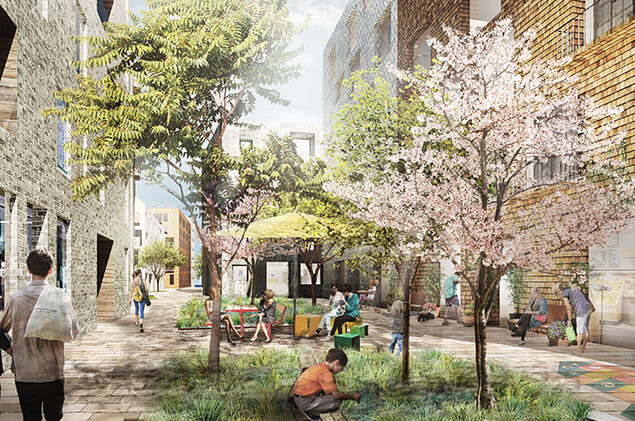
2017-05-06
Vibrant urban spaces in Stockholm Royal Seaport - Sweden's largest urban development area
2017-05-06
Vibrant urban spaces in Stockholm Royal Seaport - Sweden's largest urban development area
FOJAB arkitekter continues to design street spaces and a playground in Kolkajen, Stockholm's new waterfront district at Lilla Värtan.
The street spaces are important links in the new district and will be designed with stormwater, greenery and quality of life in focus. On the waterfront, we are designing a large playground with a natural character, where lush trees and undulating wooden structures create a stimulating play environment.
Kolkajen is part of Stockholm's major investment in the development of Stockholm Royal Seaport and one of Sweden's largest development areas. Stockholm wants to create good conditions for cyclists and pedestrians, and the ambition is to create a neighborhood that is as car-free as possible. The number of parking spaces per apartment is low. The most sustainable and climate-smart district in Sweden will be built.
FOJAB arkitekter has also worked on a quality program that forms the basis for the detailed plan for the area and for the continued design. Through a previous prequalification and parallel assignment, FOJAB arkitekter has entered into a framework agreement with the City of Stockholm for the continued work.
2017-04-15
Five questions to landscape architect Sara Schlyter
Sara Schlyter is a landscape architect at FOJAB and is passionate about public space and the importance of greenery. We took the opportunity to ask Sara five questions. Among other things, how landscape architects can contribute to a good outdoor environment in connection with densification.
What is the hottest issue for you right now?
It is difficult! The landscape is everything - it is city and nature and the interaction between them. Landscape architecture is very much about wholeness and relationships between different elements. On the large scale and the small scale....
Urban densification is on everyone's lips and construction is taking place like never before. How can landscape architects contribute to a good outdoor environment in connection with densification?
Landscape architects create quality in the outdoor environments of the dense city. The denser the city, the higher the demands on the design of the spaces in between, and more functions must be combined in the same areas. The denser the city, the more important greenery is from several aspects. It manages stormwater and balances the city's microclimate, creates a human scale, an attractive cityscape and opportunities for recreation. The city should also be a social arena, where there should be space and opportunities for everyone, not least for children.
Many of these values are difficult to measure, and we are unfortunately seeing the effects of this in many newly planned areas around the country, from flooding issues to microscopic preschool playgrounds. Density comes at a price. We need to find new ways of counting. Ultimately, it is the responsibility of the municipalities to monitor and pursue these issues, but we also need to be better at spreading knowledge about the city as a whole to everyone involved in building society.
Flexibility and multifunctionality become key words when we landscape architects work with individual places in the city. Examples include playgrounds that are combined with floodplains and create opportunities for water play, the parking lot is a ball field at certain times of the day, biofilters are combined with comfortable green seating and rooftop parks. We see the increased need to address climate change and the environment as an asset and believe that making natural processes visible adds value to the urban environment.
You are particularly passionate about public space, in what way is it important and what do you think it will mean in the future?
Public space in the city - squares, streets and parks - is a big part of a city's identity and soul. It is where we move and stay, where we walk and meet friends. Caring for public space reflects a city or community's care for its inhabitants.
Interestingly, public space is used to put a new area on the map. Then parks or places are established before the buildings take shape. This has been done, for example, in Carlsberg in Copenhagen and also the Jubilee Park in Frihamnen in Gothenburg. This shows the importance of public space for the attractiveness and branding of a city or district.
There is no doubt that people feel better when they spend time in natural environments - shouldn't more effort be put into this?
Absolutely! Proximity and access to nature or green spaces has a major impact on both health and quality of life. There is research that proves this. The problem may be that it is a socio-economic investment where the return does not end up in the wallet of the person paying for it.
Fortunately, it seems that awareness of this is increasing, both among developers and end consumers, i.e. home buyers. There is currently a demand for both nature-based housing and perhaps even more urban housing that can offer proximity to greenery and even opportunities for cultivation in the dense city.
Finally, what project are you currently working on?
Right now I'm working with Kolkajen in Norra Djurgårdsstaden in Stockholm, where we are doing system documentation for a large playground right on the water. I am also working on a concept to renew the pedestrian streets in Landskrona with greenery and living environments. I am also working on several exciting office and housing projects and a new football stadium in central Uppsala, Studenternas. It's great fun with that variety and breadth!
2017-04-10
House architect - an honorable task
In 2016, the National Property Board appointed Mattias Hedberg Ek as house architect for the Kristianstad residence. The appointment is for six years with the possibility of a three-year extension.
As house architect and general consultant for the Residence in Kristianstad, Mattias Hedberg Ek is responsible for the building's maintenance and development. In close cooperation with the National Property Board, the house architect ensures that the architectural, artistic, antiquarian and technical views are met and that quality and continuity are achieved in the ongoing care of the building. House architects have a six-year appointment with the possibility of a three-year extension. The assignment is personal.
- House architect is an honorable and extremely interesting job. It is about preserving and refining, without destroying the historical values. Architecture on a small scale that has a big impact," says architect Mattias Hedberg Ek.
The residence in Kristianstad was designed by architect Fredrik Wilhelm Scholander and built in 1857-1860. At that time, the building was the residence of the county governor and premises for the county council. It was later expanded with, among other things, several floors. The residence, which has been a listed building since 1935, is today partly empty and is used as an office for the Swedish National Land Survey, among others.
Conservation of a national monument
Over the next few years, the residence will be renovated and adapted for new functions and tenants. A facade renovation is currently being carried out in collaboration with another architect. The representation floor will eventually be converted into office space.
- It is desirable to modernize and attract businesses. Much work lies in preserving the room structure but at the same time adapting the premises to today's modern needs," says Mattias Hedberg Ek.
Close cooperation is crucial
Old houses and buildings require skilled designers and close cooperation is therefore essential. The house architect is responsible for the overall project and for coordinating the necessary skills. For example, specialists in fire, plumbing, lighting, coloring, environment, sheet metal and painting.
2017-03-29
Academia meets working life at Arkipelago in Lund and Stockholm
In March 2017, ambitious architecture students had the opportunity to meet FOJAB architects and other industry representatives at the Arkipelago labor market days in Lund and Stockholm. Questions about what a day in the life of an architect looks like and the key skills available in the office were discussed, and the fair also gave FOJAB architects the opportunity to meet the talents of tomorrow.
Arkipelago is a collaborative project between Sweden's architectural education programs and arranges lectures, mingling events, workshops and annual labor market days in Lund, Stockholm, Karlskrona, Umeå and Gothenburg. FOJAB arkitekter has participated in the days in Lund and Stockholm since the start in 2011 and so also this year.
At Arkipelago in Lund, Camilla Henricson, Kristina Kember, Caroline Lindqvist and Axel Stolt from FOJAB arkitekter participated. On site, they exchanged ideas and thoughts, tips on how to best design their portfolio, and how students can best get a foot in the door to working life after graduation. Three students also won the opportunity to visit FOJAB's office in Malmö for breakfast, an inspiring lecture and an insight into life at an architectural office.
- Arkipelago is an important meeting place also for us architects as it gives us an opportunity to exchange thoughts and ideas with architecture students with fresh eyes. It also gives us an opportunity to find the new talents that we are constantly looking for in our growing industry, says Camilla Henricson, Architect MSA at FOJAB arkitekter in Malmö.
2017-03-22
FOJAB arkitekter invests in digital excellence
FOJAB arkitekter has made a strategic decision to develop the area of Computational Design under the name FOJABcode. This is a long-term investment in design research in a testbed environment to develop new methods and models in digital design. FOJAB is now recruiting to get a strong team with a focus on both design and programming.
Petra Jenning, an architect at FOJAB arkitekter and internationally recognized expert in Computational Design, is responsible for the development work.
- "The digital approach we are exploring differs from the current one in that we model behaviors and processes instead of static geometry," says Petra Jenning. Various activities are now underway around the world to understand how this can work in practice, and what changes it brings at different stages. These activities take place both in academia and in industry. We want to be at the forefront here.
The development work will be done internally but with exchange and cooperation with other companies and organizations moving in the same direction. The aim is to test models and methods, which when mature can be applied in the projects.
- FOJAB arkitekter started in Lund with close links to LTH and research. Over the years, that relationship has remained on many levels, says CEO Daniel Nord. "What is new is that we now work proactively and methodically with the practical application of what new research produces. This can benefit all of FOJAB's customers.
Petra Jenning describes current construction methods as a consequence of a reductionist process; each requirement, such as climate protection, strength and ventilation, has its own solution and is considered individually. This means that we quickly become limited by increasing complexity as new requirements are added. New technology offers opportunities to think about problem solving in new ways. It is possible to let the computer generate solutions in which interaction and feedback between different functions and systems are incorporated into the design process.
- The result will be integrated solutions that can respond to a variety of local and unique requirements and still be practically and economically feasible," says Petra Jenning.Within FOJABcode, we will look broadly at the design process. Digitalization brings completely new opportunities. The mission is about exploring those opportunities and finding synergies. We need to take a holistic approach to what digitalization means for the entire chain of the construction process - from design to production to finished house - and beyond.
2017-03-13
FOJAB's seasonal parks lead the way in Landskrona
FOJAB's vision proposal was selected in a parallel assignment in Koppargården, Karlslund in Landskrona. This early vision will now show the way in the continued work with the area where the goal is to achieve a denser, more varied building and new attractive spaces, while preserving a large part of today's apartments and streets.
The city of Landskrona sees great opportunities for the Karlslund district in northern Landskrona and is now, in cooperation with the property owners, taking a comprehensive approach to the development of the area. The goal is to improve the environment in the area and develop an attractive residential area in the growing city. In a parallel assignment for the Koppargården sub-area with Landskronahem as the client, FOJAB has developed an early vision for the area.
- "We are very pleased that Landskronahem chose to proceed on the basis of our ideas about Koppargården's potential. Our proposal is called Årstidsparkerna after the four smaller parks with strong seasonal characters that have been created in the central parts of the proposal," says Karin Fagerberg of FOJAB.
Seasonal parks are a cross between a square and a park. They are intended to complement the area's generous green spaces and sports facilities and help develop the area's identity. The vision includes 1600 homes, including the existing ones, and two new pre-schools. The new housing consists of a mix of apartment buildings in an open block structure and terraced houses. New, diagonal streets lead into the recreational area. A consistent idea is that the area should be easy to navigate and that residents should always be close to a park or other meeting place.
- FOJAB's idea proposal is the one that best matches our ambitions for the area. The proposal will therefore guide the work together with the city, other property owners and tenants on the transformation, says Helena Fremle, CEO of Landskronahem.
The architectural team at FOJAB consists of Karin Fagerberg, Kjell Adamsson, Pia Månsson, Mikael Pettersson and David Kisch.
2017-03-07
FOJAB arkitekter appoints three new studio managers
As of March 1, FOJAB arkitekter has appointed three new studio managers.
In Helsingborg, Rebecca Saaby Mehlum takes over from Staffan Premmert. Staffan will continue to work as a commissioned architect.
In Stockholm, the office is split into two studios due to the strong growth. The studios will be headed by Eva Ocklund and Cecilia Jarlöv respectively, with Jens Larsson continuing as Office Manager.
"I am pleased that we had three such competent, internal candidates for the positions and look forward to the continued development of the studios", says Karin Fagerberg, Operations Manager at FOJAB arkitekter.
2017-02-07
Hansa - one step closer to opening
Since 2015, Hansa, the large department store between Stora Nygatan and Södra Promenaden in central Malmö, has been undergoing extensive design changes. We at FOJAB arkitekter are responsible for the design and planning with a focus on refining this central meeting place. Naturally, the ambition is for the old NK building to once again become a strong commercial center. The inauguration will take place in the fall of 2017, but large parts are already ready.
Hansa opened already in 1963, but then as NK. In the 1990s, the department store changed its name to Hansacompagniet. Now Hansa is undergoing a fundamental change. In close cooperation with the client AREIM and HEA Property Partner, FOJAB arkitekter is working to refine Hansa's two blocks into a modern and attractive shopping area in the center of Malmö.
Kv. Stadt Hamburg, Hansagallerian, has already been largely rebuilt with several new players and a completely new design. The block has changed with more shop entrances and major facade changes to open up for a more active urban life around the buildings.
Kv. Lybeck, the Hansa department store, will go back to being a more open department store of the NK character, with more entrances than today and a new facade. With this concept comes changed opening hours and thus more people in the evenings.
At the same time, the blocks contain much more than just the retail space in Hansa. There are also offices, housing, a parking garage, a school and a medical center. Many of these activities are being designed and built in parallel with the redevelopment of the shopping area.
The whole is expected to be completed in the fall of 2017 when the grand opening will take place.

